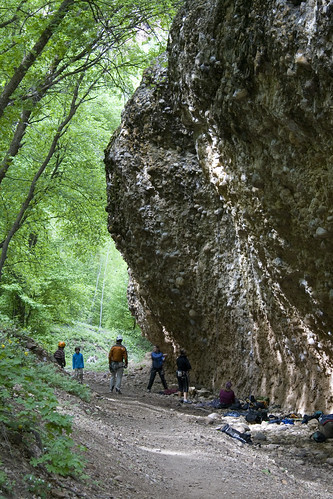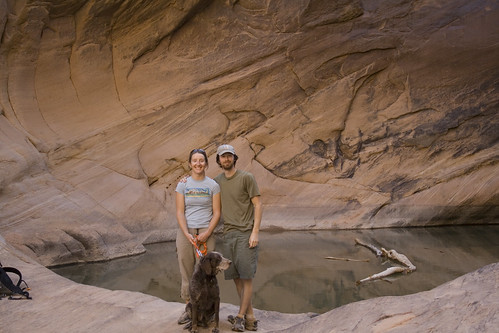
It's been a while since we posted. Springtime has fully hit the Wasatch and we've been busy trying to make the most of our weekends. During that in between stretch of not enough snow to ski, but too much to hike, it seems like the snow piles are never going to leave the street. But of course they finally do, snow is gone, river is raging, trees have leafed out and the hummingbirds are back. We have two feeders that these guys can go through in a day. Our sugar usage increases significantly this time of year, but it's worth it to watch 3 different types of hummingbirds zooming all around, fighting for territory (these guys can be mean!) then sitting peacefully together for a few seconds to drink some food before starting territory battles all over again.
I had thought that when we moved to Utah, that it was a place where it doesn't rain very much. I thought I had left the springtime rain behind in Oregon. Somehow though in the last 6 weekends, I think we've had 2 dry ones! We were both pretty grumpy on Friday evening when we checked the forecast and found that it was supposed to rain, pretty much everywhere in Utah, the whole long weekend! In spite of a 60% chance on Saturday and 40% on Monday, we drove down to Maple Canyon both days which has the craziest cobblestone conglomerate rock for supper fun climbing. It drizzled a bit on us, but we were climbing in the pipeline which is mostly overhanging so it stayed mostly dry. We were reminded that Maple is a good place to wear helmets or leg guards rather as we saw a woman get hit in the calf by a rolling rock then Matt get hit in the thigh from a rock whizzing down from somewhere above. No major harm done in either case, just some nice bruises, but a little bit of a wake up call. We were both projecting some harder climbs, which we didn't quite get cleanly, but made good progress on.


A couple weekends ago we went down to Cedar City with the club to climb at Pocket Rocks. As you can guess, the rock is full of pockets and quite fun to climb on. It's a bit like Smith Rocks, only much smaller and less spectacular. After 3 days of chasing lizards in the sun, Mojo slept for 4 days straight, but is now fully recovered and disappointed we did not go to a lizard filled spot this weekend, only the typical birds and squirrels which aren't nearly as exciting.
One of the best parts about spring where we live is the alpine loop road. It's closed all winter about 2 miles above our place, so great cross country skiing in the winter. This time of year, it's still closed for a few more weeks, but the road is still closed, so we have our own mostly private access for running and hiking where we can watch spring in all different stages as we go up in elevation. In a few weeks, it will be full of tourists again, but it will mean we can access some of our favorite trails and make it over the mountain to American Fork.
That's the highlights of spring in the Wasatch, we're hoping it stays spring a bit longer before switching to the blazing heat of summer. Matt's much better at keeping pictures updated on our flickr website, than we have been with the blog, so check our flickr page out when you get a chance.
Hi All (Matt here adding my comments)
Since our last post most of what we've been doing is bouldering and climbing. Little Cottonwood has great bouldering and Triassic (our weekend getaway) has been terrific even though the weather in the mountains has been rainy and unclimbable. We've been to Ibex as well. During the evenings we've been going to Rock Canyon a good bit and pretty soon American Fork will be a more frequented destination. As far as sending goes it's been a great spring. Cassie onsighted or flashed all of her problems at Pocket Rocks, and I've been sending some of my hardest boulder problems. V6s are getting a bit easier and I'm hoping to send a V7 before the end of the year.

Right now we're both projecting hard routes at Maple. Cassie has her sights set on an 11b pumpy overhanging route at the Pipeline and I'm trying a 11d and a 12b which are also at the Pipeline. Cassie took two lead falls today and I think she's making great progress controlling her fear of falling. I think next weekend the 11s we will probably send and maybe I'll make some progress on my 12. It's funny how climbing works. Even though Cassie and I are both capable of climbing 5.12 it takes a lot of work and effort to complete a problem. For those of you who are not familiar with climbing lingo a "send" is the ability on lead (lead means you are not on toprope) to climb a route without hanging on any of your gear from the ground up and without falling. Many people can climb super hard on toprope, but the true test of your ability is to lead.

In other news we went to the San Rafael Swell and Goblin Valley a few weekends ago. We went to a place called Eardley Canyon and the "Amazing Pool" (seriously that's the name of the pool). It was a beatiful weekend and we had a great time even though Cassie was pretty sick.

So, we're still having fun and loving our lives here in Utah. Hope everyone else out there is well!

